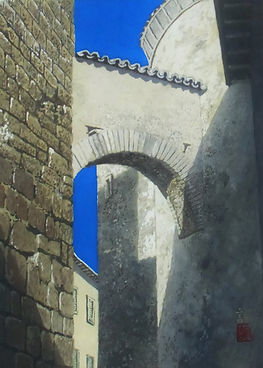MAKOTO TAKAHASHI
Nihonga-Japanese Painting
The Interval Between Two Extremes: Memories of Italy.
Light and shadow, brightness and darkness, white and black – it is the space between these conflicting extremes that I strive for. The slight shadow in a bright light, the slight glimmer in the dark shadows – it is these intervals that contain a universal beauty.
The Italian streetscape is for me both an emotionally moving and nostalgic scene. The radiant rays of light that pour from sunshine and the deep darkness of the shadows - these show the eve-present flow of time and the ebb and flow of the people who live there.
I am now using Nihonga, a traditional form of Japanese painting, to create these Italian landscapes. I want to show the world the yet unknown beauty of the natural mineral pigments used by Nihon-ga and the beauty of Japan’s traditional culture.
A New Expression: The Fusion of Japan and the West.
Nihonga is a process that utilizes natural mineral pigments painted onto traditional Japanese Washi paper. These pigments are only found in Japan and create natural colors that are both tender and vivid and can’t be produced via other materials. The blue used in my piece ‘M & Blue’ is called ultramarine, made from ground azurite and has been used since the olden days of Japan. It is a color as dazzling as the finest of jewels. The deep vivid of nature of ultramarine can express the bright refreshing nature of Italian landscapes, it is a very special tone. The very nature of the mineral pigments used means that the sand-like grains that protrude from the canvas give the art very unique characteristics. This effect is similar to the texture of those old Italian walls that have seen many long years of history and have developed a rich personality of their own. This is why I chose to use these natural pigments for my Nihonga work.
Nihonga, much like other Japanese art-forms such as Kimono, Byōbu folding screens and Ukiyo-e present a flatness in objects. Whereas, Western paintings express shadows, light and brightness through the portrayal of space and the dimensional nature of objects. I, however, try to express the traditional flat composition of Japanese art through the light and shadow of Italian landscapes. In other words, I am utilizing a new fusion of Japanese and Western styles.
